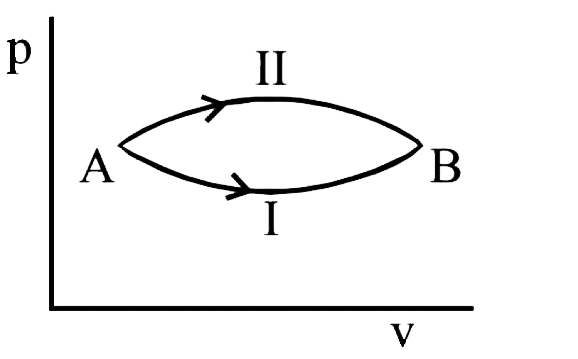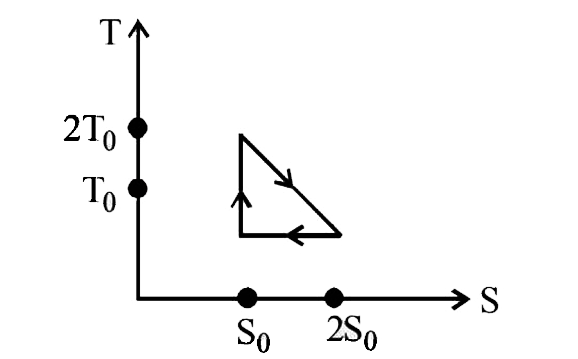Complete Solutions to Chapter Test of chapter KINETIC THEORY OF GASES AND THERMODYNAMICS of Class 11 book with complete answers and questions
| Class 11 | PHYSICS |
| Chapter | KINETIC THEORY OF GASES AND THERMODYNAMICS |
| A2Z | Chapter Test |
| Number Of Questions | 29 |
| Academic Year | 2023-24 |
First law of thermodynamics is a special case of
01:15View SolutionA Carnot engine takes `3xx10^6cal`. of heat from a reservoir at `62^@C`, and gives it to a sink at `27^@C`. The work done by the engine is
02:25View SolutionWhich of the following statements is correct for any thermodynamic system?
01:41View SolutionWhich of the following is incorrect regarding the first law of thermodynamics?
01:24View SolutionDuring an adiabatic process, the pressure of a gas is found to be proportional to the cube of its absolute temperature. The ratio `C_P//C_V` for the gas is
01:22View SolutionA system goes from A and B via two processes. I and II as shown in figure. If `DeltaU_1 and DeltaU_2` are the changes in internal energies in the processes I and II respectively, then
 02:05View Solution
02:05View SolutionThe temperature -entropy diagram of a reversible engine cycle is given in the figure. Its efficiency is
 02:07View Solution
02:07View SolutionAn ideal monoatomic gas is taken the cycle `ABCDA` as shown in following `P-V` diagram. The work done during the cycle is
 02:48View Solution
02:48View SolutionWhen an ideal diatomic gas is heated at constant pressure, the fraction of the heat energy supplied which increases the internal energy of the gas is
01:52View SolutionTwo identical containers A and B with frictionless pistons contain the same ideal gas at the same temperature and the same velocity V. The mass of the gas in A is `m_A,` and that in B is `m_B`. The gas in each cylinder is now allowed to expand isothermally to the same final volume 2V. The changes in the pressure in A and B are found to be `DeltaP and 1.5 DeltaP` respectively. Then
04:20View SolutionTwo cylinders A and B fitted with pistons contain equal amounts of an ideal diatomic gas at 300K. The piston of A is free to move, while that B is held fixed. The same amount of heat is given to the gas in each cylinder. If the rise in temperature of the gas in A is 30K, then the rise in temperature of the gas in B is
02:55View SolutionA gas mixture consists of 2 moles of oxygen and 4 moles of argon at temperature T. Neglecting all vibrational modes, the total internal energy of the system is
03:32View SolutionA monoatomic ideal gas, initially at temperature `T_1,` is enclosed in a cylinder fitted with a friction less piston. The gas is allowed to expand adiabatically to a temperature `T_2` by releasing the piston suddenly. If `L_1 and L_2` are the length of the gas column before expansion respectively, then `(T_1)/(T_2)` is given by
02:47View SolutionIn a given process on an ideal gas, `dW=0 and dQlt0.` Then for the gas
03:04View SolutionWhich of the following graphs correctly represents the variation of `beta=-(dV//dP)/V`
with P for an ideal gas at constant temperature?02:14View SolutionAn ideal gas is taken through the cycle `AtoBtoCtoA,` as shown in the figure, If the net heat supplied to the gas in the cycle is 5J, the work done by the gas in the process `CtoA` is
 02:28View Solution
02:28View SolutionAn ideal gas expands isothermally from volume `V_(1)` to `V_(2)` and is then compressed to original volume `V_(1)` adiabatically. Initialy pressure is `P_(1)` and final pressure is `P_(3)`. The total work done is `W`. Then
02:52View SolutionAn ideal gas is filled in a closed rigid and thermally insulated container. A coil of `100Omega` resistor carrying current 1 A for 5 minutes supplies heat to the gas. The change in internal energy of the gas is
03:58View SolutionA Carnot engine operates between `327^(@)C` and `27^(@)C` How much heat (in joules) does it take from the `327^(@)C` reservoir for every `100 J` of work done?
02:08View SolutionOne mole of gas having `gamma = 7//5` is mixed with 1 mole of a gas having `gamma = 4//3`. What will be `gamma` for the mixture ?
01:31View SolutionTwo cylinders A and B fitted with pistons contain equal amounts of an ideal diatomic gas at 300K. The piston of A is free to move, while that B is held fixed. The same amount of heat is given to the gas in each cylinder. If the rise in temperature of the gas in A is 30K, then the rise in temperature of the gas in B is
02:55View SolutionInternal energy of `n_(1)` mol of hydrogen of temperature `T` is equal to the internal energy of `n_(2)` mol of helium at temperature `2T`. The ratio `n_(1) // n_(2)` is
01:14View SolutionAn ideal gas `(gamma = 1.5)` is expanded adiabatically. How many times has the gas to be expanded to reduce the roo-mean-square velocity of molecules becomes half ?
02:02View SolutionIf 2 mol of an ideal monatomic gas at temperature `T_(0)` are mixed with 4 mol of another ideal monatomic gas at temperature `2 T_(0)` then the temperature of the mixture is
01:45View SolutionThree samples `A`, `B` and `C` of the same gas `(gamma = 1.5)` have equal volumes and temperatures. The volume of each sample is doubled, the process being isothermal for `A`, adiabatic for `B` and isobaric for `C`. If the final pressures are equal for the three samples, Find the ratio of the initial pressures.
04:55View Solution`P - V` diagram of an ideal gas is as shown in figure. Work done by the gas in process `ABCD` is
 02:50View Solution
02:50View SolutionStatement I: The specific heat of a gas in an adiabatic process is zwero but it is infinite in an isothermal process.
Statement II: Specific heat of a gas is directly proportional to heat exchanged with the system and inversely proportional to change in termperature.01:41View SolutionAsssertion: It is not possible for a system, unaided by an external agency to transfer heat from a body at lower temp. to another at a higher temp.
Reason: It is not possible to violate the second law of thermodynamics.01:31View SolutionAssertion : First law of thermodynamics is a restatement of the principle of conservation.
Reason : Energy is fundamental quantity.01:17View Solution
Chapter Test questions and complete solutions for chapter KINETIC THEORY OF GASES AND THERMODYNAMICS of A2Z PHYSICS (HINGLISH) of Class 11
